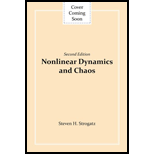
Concept explainers
Interpretation:
For the functional equation g(x) = αg2(xα), arise in renormalization analysis of period doubling.
If g(x)≈1+c2x2 for small x, then solve for c2 and α
For g(x)≈1+c2x2+c4x4, solve equation for c2, c4 and α, and compare the results with exact values c2≈-1.527..., c4≈0.1048... and α≈-2.5029...
Concept Introduction:
The power series expansion of the g(xα) is
g(xα) = 1+c2(xα)2+c4(xα)4+...
Answer to Problem 1E
Solution:
α=−2.73205 and c2=−1.36603
α=−2.534... c2=−1.52224... c4=0.12761... and these are compared with exact values of α,c2 and c4
Explanation of Solution
The function equation arose in renormalization equation is,
g(x) = αg2(xa)
The power series expansion of the above equation is
g(xα) = 1+c2(xα)2+c4(xα)4+...
g2(xα)=g(g(xα))=g(1+c2(xα)2)=1+c2+2c22(xα)2+O(x4)
∴αg2(xa)=α(1+c2+2c22(xα)2+O(x4))=α(1+c2)+2c22x2α+αO(x4)
The given approximation is
g(x)=1+c2x2
Comparing this with αg2(xa)
1 + c2x2 = α(1+c2)+2c22x2α + O(x3)
Comparing the coefficients of x0 and x2
1= α(1+c2)
c2=2c22α
Solving above two equations
⇒(α,c2)={(1,0)(−1−√3,−1−√32)≈(−2.73205,−1.36603)(−1+√3,−1+√32)≈(0.732051,0.366025)
Here, take the second solution because in that solution α is closer to Feigenbaum α=−2.5...
g(x) = αg2(xa)=α(1+c2+c4+2(c22+2c2c4)(xα)2+(c32+6c22c4+2c2c4+c24)(xα)4+O(x5))
The given approximation is
g(x)=1+c2x2+c4x4
Equating this with αg2(xa)1+c2x2+c4x4=α(1+c2+c4)+2(c22+2c2c4)x2α+(c32+6c22c4+2c2c4+c24)x4α3+O(x5)
Comparing the coefficients of x0,x2and x4, we get
1= α(1+c2+c4)
c2=2(c22+2c2c4)α
c4=(c32+6c22c4+2c2c4+c24)α3
Using first and second equations for solving c2 and c4 in terms of α
c2=−2+2α−α2
c4=1−1α+α2
Substituting these values of c2 and c4 in third equation, then it becomes
4α6+3α5−60α4−104α3+168α2+240α−384+128α=0
The root of above equation closest to Feigenbaum is α=−2.534...
Substituting this value of α in c2=−2+2α−α2 and c4=1−1α+α2
α=−2.534... c2=−1.52224... c4=0.12761...
Comparing the results with exact values c2≈-1.527..., c4≈0.1048... and α≈-2.5029... they are nearly equal.
Want to see more full solutions like this?
Chapter 10 Solutions
Nonlinear Dynamics and Chaos
- Q4. Considering the following two normal distributions A and B, which statement (or statements) is correct? a) Mode of the distribution A is larger than that of distribution B. b) SD of the distribution B is larger than that of distribution A. c) Mean of the distribution A is smaller than that of distribution B. d) A data item with z-score of -1 falls between 20 to 30 in distribution A. e) A data item with z-score of +1 falls between 10 to 20 in distribution B. A 0 10 20 30 40 40 50 60 00 10 70 B 80 90 100arrow_forwardQ1. A traffic camera recorded number of red cars going through the intersection at 16th Ave N and Centre St. each day over 7 days was: 32 30 24 30 36 38 27 a) Calculate the mean, mode, range and median of the data set above. c) Calculate the standard deviation of this data set. Sarrow_forwardQ2. Government of Canada is designing Registered Retirement Saving Plans (RRSP) for Canadians. According to statistics Canada, the life expectancy in Canada is 86 years with standard deviation of 4.8 years. a) Find the z-score of a person who is 90 years old? b) Find the age of a person whose z-score is -1.4? c) What percent of people age higher than 80? d) What percent of people age less than 83? e) What percent of people age between 85 and 88?arrow_forward
- b pleasearrow_forward(b) Let I[y] be a functional of y(x) defined by [[y] = √(x²y' + 2xyy' + 2xy + y²) dr, subject to boundary conditions y(0) = 0, y(1) = 1. State the Euler-Lagrange equation for finding extreme values of I [y] for this prob- lem. Explain why the function y(x) = x is an extremal, and for this function, show that I = 2. Without doing further calculations, give the values of I for the functions y(x) = x² and y(x) = x³.arrow_forwardPlease use mathematical induction to prove thisarrow_forward
- L sin 2x (1+ cos 3x) dx 59arrow_forwardConvert 101101₂ to base 10arrow_forwardDefinition: A topology on a set X is a collection T of subsets of X having the following properties. (1) Both the empty set and X itself are elements of T. (2) The union of an arbitrary collection of elements of T is an element of T. (3) The intersection of a finite number of elements of T is an element of T. A set X with a specified topology T is called a topological space. The subsets of X that are members of are called the open sets of the topological space.arrow_forward
- 2) Prove that for all integers n > 1. dn 1 (2n)! 1 = dxn 1 - Ꮖ 4 n! (1-x)+/arrow_forwardDefinition: A topology on a set X is a collection T of subsets of X having the following properties. (1) Both the empty set and X itself are elements of T. (2) The union of an arbitrary collection of elements of T is an element of T. (3) The intersection of a finite number of elements of T is an element of T. A set X with a specified topology T is called a topological space. The subsets of X that are members of are called the open sets of the topological space.arrow_forwardDefinition: A topology on a set X is a collection T of subsets of X having the following properties. (1) Both the empty set and X itself are elements of T. (2) The union of an arbitrary collection of elements of T is an element of T. (3) The intersection of a finite number of elements of T is an element of T. A set X with a specified topology T is called a topological space. The subsets of X that are members of are called the open sets of the topological space.arrow_forward
- Algebra & Trigonometry with Analytic GeometryAlgebraISBN:9781133382119Author:SwokowskiPublisher:Cengage
